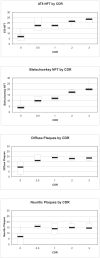The Framingham Brain Donation Program: neuropathology along the cognitive continuum
- PMID: 22471865
- PMCID: PMC3622706
- DOI: 10.2174/156720512801322609
The Framingham Brain Donation Program: neuropathology along the cognitive continuum
Abstract
The Framingham Heart Study has enrolled 3 generations of participants, the original cohort (gen 1) enrolled in 1948, the offspring cohort (gen 2) enrolled in 1971 and the third generation enrolled in 2002. Participants have been undergoing prospective surveillance for incident stroke and dementia and embedded within this cohort is the voluntary Framingham Brain Donation Program that was begun in 1997. Participants who register to become brain donors have had one or more brain MR and cognitive test batteries administered. In addition, they undergo neurological evaluation as indicated, record review and post-mortem next-of-kin interview to determine the presence, type and extent of antemortem, clinical neurological diagnoses and to assign a retrospective clinical dementia rating (CDR) Scale score. Between 1997 and 2009 there were 1806 deaths, 186 of which were among registered brain donors and of these 139 brains could be examined. 58% were deemed cognitively normal at death. We present results for 3 projects; the first was to examine the sensitivity and specificity of our clinical diagnosis against the gold standard of pathological AD in 59 persons who underwent detailed cognitive assessment in the two years prior to death; we observed a 77.3% sensitivity (2 persons with AD were diagnosed clinically as Lewy body dementia) and a 91.9% specificity. The second examined the correlation of regional Alzheimer-type pathology to cognitive status at death among 34 persons who were over the age of 75 and without any significant vascular or alternative neurodegenerative pathology and found that neurofibrillary tangle counts distinguished between persons who were controls, had mild cognitive impairment, mild or moderate dementia; tangles in dorsolateral frontal cortex best distinguished MCI and controls. The third project examined the extent and severity of vascular pathology, again in a larger sample of varying cognitive abilities and in a subsample of persons with either amnestic or nonamnestic MCI. We observed that an aggregate ischemic injury score was significantly higher in persons with a CDR score of 0.5 than in normal controls.
Conflict of interest statement
Figures
Similar articles
-
Neuropathology of older persons without cognitive impairment from two community-based studies.Neurology. 2006 Jun 27;66(12):1837-44. doi: 10.1212/01.wnl.0000219668.47116.e6. Neurology. 2006. PMID: 16801647 Clinical Trial.
-
Mild cognitive impairment is related to Alzheimer disease pathology and cerebral infarctions.Neurology. 2005 Mar 8;64(5):834-41. doi: 10.1212/01.WNL.0000152982.47274.9E. Neurology. 2005. PMID: 15753419
-
Association Between Olfactory Dysfunction and Amnestic Mild Cognitive Impairment and Alzheimer Disease Dementia.JAMA Neurol. 2016 Jan;73(1):93-101. doi: 10.1001/jamaneurol.2015.2952. JAMA Neurol. 2016. PMID: 26569387 Free PMC article.
-
Spectrum of cognition short of dementia: Framingham Heart Study and Mayo Clinic Study of Aging.Neurology. 2015 Nov 10;85(19):1712-21. doi: 10.1212/WNL.0000000000002100. Epub 2015 Oct 9. Neurology. 2015. PMID: 26453643 Free PMC article. Review.
-
Contributions of the Framingham Heart Study to stroke and dementia epidemiologic research at 60 years.Arch Neurol. 2012 May;69(5):567-71. doi: 10.1001/archneurol.2011.977. Arch Neurol. 2012. PMID: 22213410 Free PMC article. Review.
Cited by
-
The Neutrophil to Lymphocyte Ratio Is Associated With the Risk of Subsequent Dementia in the Framingham Heart Study.Front Aging Neurosci. 2021 Nov 30;13:773984. doi: 10.3389/fnagi.2021.773984. eCollection 2021. Front Aging Neurosci. 2021. PMID: 34916927 Free PMC article.
-
Identifying Proteomic Prognostic Markers for Alzheimer's Disease with Survival Machine Learning: the Framingham Heart Study.medRxiv [Preprint]. 2024 Sep 23:2024.09.21.24314123. doi: 10.1101/2024.09.21.24314123. medRxiv. 2024. Update in: J Prev Alzheimers Dis. 2025 Feb;12(2):100021. doi: 10.1016/j.tjpad.2024.100021. PMID: 39399041 Free PMC article. Updated. Preprint.
-
Mid-life and late-life vascular risk factor burden and neuropathology in old age.Ann Clin Transl Neurol. 2019 Dec;6(12):2403-2412. doi: 10.1002/acn3.50936. Epub 2019 Nov 5. Ann Clin Transl Neurol. 2019. PMID: 31691546 Free PMC article.
-
Building a pipeline to discover and validate novel therapeutic targets and lead compounds for Alzheimer's disease.Biochem Pharmacol. 2014 Apr 15;88(4):617-30. doi: 10.1016/j.bcp.2014.01.037. Epub 2014 Feb 6. Biochem Pharmacol. 2014. PMID: 24508835 Free PMC article. Review.
-
Methionine Sulfoxide Reductase-B3 (MsrB3) Protein Associates with Synaptic Vesicles and its Expression Changes in the Hippocampi of Alzheimer's Disease Patients.J Alzheimers Dis. 2017;60(1):43-56. doi: 10.3233/JAD-170459. J Alzheimers Dis. 2017. PMID: 28777754 Free PMC article.
References
-
- Dawber TR, Kannel WB. The Framingham study. An epidemiological approach to coronary heart disease. Circulation. 1966;34:553–555. - PubMed
-
- Feinleib M, Kannel WB, Garrison RJ, McNamara PM, Castelli WP. The Framingham Offspring Study. Design and preliminary data. Prev Med. 1975;4:518–525. - PubMed
-
- Splansky GL, Corey D, Yang Q, Atwood LD, Cupples LA, Benjamin EJ, et al. The Third Generation Cohort of the National Heart, Lung, and Blood Institute's Framingham Heart Study: design, recruitment, and initial examination. Am J Epidemiol. 2007;165:1328–1335. - PubMed
-
- Bachman DL, Wolf PA, Linn R, Knoefel JE, Cobb J, Belanger A, et al. Prevalence of dementia and probable senile dementia of the Alzheimer type in the Framingham Study. Neurology. 1992;42(1):115–9. - PubMed
-
- Bachman DL, Wolf PA, Linn RT, Knoefel JE, Cobb JL, Belanger AJ, et al. Incidence of dementia and probable Alzheimer's disease in a general population: the Framingham Study. Neurology. 1993;43(3 Pt 1):515–9. - PubMed



